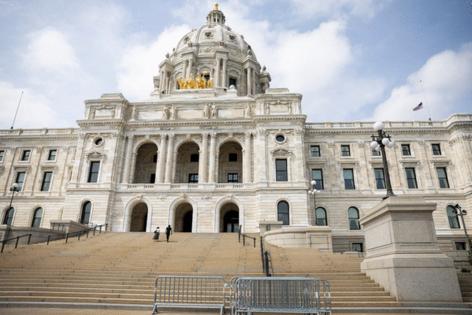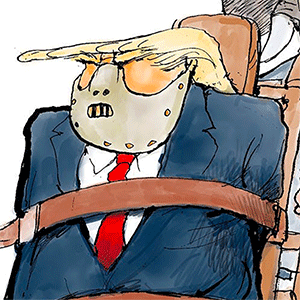How Minnesota's political culture complicates security at the Capitol
Published in News & Features
Minnesotans looking to praise, protest or petition their government have gathered at the State Capitol for more than a century.
Farmers packed the rotunda during the Great Depression to demand farm aid. In 1964, Minnesotans gathered to pray as the U.S. Senate debated the Civil Rights Act. Anti-abortion activists gather every year to advocate for stricter policies.
“Rallies, demonstrations, press conferences,” said Brian Pease, the Minnesota Historical Society State Capitol site manager. “You name an event, it’s probably been held here.”
In all that time, nobody has walked through a permanent metal detector to get into the main spaces of the Capitol, a point of pride for many lawmakers and state residents. Increasingly, that makes Minnesota an anomaly.
The assassination of former House Speaker Melissa Hortman and her husband and the shooting of Sen. John Hoffman and his wife have renewed a longstanding debate over access vs. safety in the seat of state government.
The relevance of those security concerns was highlighted again this weekend, when a man apparently experiencing mental health concerns was found in the Senate chamber, according to an email sent to legislators by House Chief Sergeant at Arms Lori Hodapp. She wrote that officials are investigating how the man, deemed to be non-threatening, got into the building after hours.
When the committee that oversees Capitol security meets Aug. 20, conversations about metal detectors and other heightened security measures seem inevitable. Ramsey County Sheriff Bob Fletcher has already urged state leaders to add metal detectors and bag checks at the Capitol.
“This is ridiculous; why are we not a state that does this?” DFL Rep. John Huot told the Star Tribune earlier this month, calling on Minnesota to adopt a screening process for entering the building.
Former Legislative Auditor Jim Nobles, whose office raised concerns years ago about security vulnerabilities, said similar discussions have come and gone over the years.
He said lawmakers often balk at adding the heavier security found at other state capitols. Even seemingly simple proposals get complicated quickly by cost, culture, politics and building design.
Nobles said he’s not convinced this time will be different.
“Who are you securing from what, where, when?” he said. “I think that is one of the things that keeps legislators and other public officials from doing much: It’s just daunting.”
Minnesota’s Capitol complex has added some security measures over the years.
The are roughly 100 people who work to keep the complex safe, and cameras and keycard access to many buildings, said State Patrol spokesperson Kyle Everson.
A fence went up around the Capitol amid unrest following George Floyd’s murder. It remained up until June 2021.
Minnesota is one of about 10 states that don’t require security screening, like metal detectors or X-ray machines, for visitors entering their capitols, said Tim Storey, CEO of the National Conference of State Legislatures.
Some of the other holdouts are Wisconsin, New Hampshire, Nebraska, Idaho, Montana and Washington.
Many states that boosted security have done so since the Sept. 11, 2001, attacks, Storey said. But officials across the country struggled with those decisions, he said, “Because, hey, we want this to be a welcoming place.”
Minnesota still struggles with that tension.
Paul Soper, a senior lecturer in the University of Minnesota’s political science department, said that’s not entirely surprising.
Some political scientists categorize Minnesota among states that have “moralistic” political cultures that value the commonwealth over individualism or elitism, Soper said.
“The idea was that the political sphere belonged to all citizens, not just an elite. And that idea was transmitted as New Englanders moved out of New England and into upstate New York and into Michigan and Wisconsin and Minnesota,” he said.
Soper said the political culture theory might help explain Minnesota’s position.
Amy Koch, a lobbyist who served in the Minnesota Senate, including as Republican majority leader, said out-of-state clients are often surprised they can enter the Capitol without going through security.
She said it’s something many Minnesotans on both sides of the aisle are proud of, along with high voter turnout, ticket-splitting and having elected a third-party governor.
“We are a purple-y state,” she said. “We pride ourselves on civility and transparency and access.”
Koch said she’s been firmly on the side of keeping the Capitol easily accessible, even after experiencing scary situations during her time in leadership.
But it’s something she’s rethinking after June’s shootings.
She said Minnesotans’ “we can handle ourselves” attitude about security has “been proven to be terribly, terribly incorrect.”
Koch said she hopes any increased security measures will be accompanied by efforts to make the process of governing — increasingly given over to an opaque committee process and tome-length omnibus bills — more transparent.
A spokesperson for Lt. Gov. Peggy Flanagan, who heads the the Advisory Committee on Capitol Area Security, didn’t respond to a request for comment.
Capitol architect Cass Gilbert meant for Minnesotans to feel something when they walked up the marble stairs to the heavy front doors, stepped into a hall and then into the soaring rotunda, decorated with Minnesota and classical motifs, said Pease of the Historical Society.
“The concept is, you’re coming into a building of importance,” he said. “And what happens here affects everyone in the state of Minnesota.”
The public’s role in what happens there was reaffirmed nearly a decade ago, when a massive Capitol renovation doubled the public gathering space.
Keeping the Capitol safe is different than securing offices or courts — government buildings that serve a narrower purpose, said State Patrol Captain Eric Roeske, who directs capitol security.
“It’s the hub of state government,” Roeske said. “It’s also a tourist attraction, a space where large events occur, schoolchildren come here on a daily basis.”
As the Advisory Committee on Capitol Security discusses the issue in coming months, Annastacia Belladonna-Carrera, the executive director of Common Cause Minnesota, urged its members to include the public.
“The openness that is there ... is not accidental,” she said. “It reflects that deeply rooted political culture and values of accessibility, of civic participation, and that belief that government should be physically, not just symbolically, but physically close to the people it serves.”
_____
(Jessie Van Berkel of the Minnesota Star Tribune contributed to this story.)
_____
©2025 The Minnesota Star Tribune. Visit startribune.com. Distributed by Tribune Content Agency, LLC







Comments